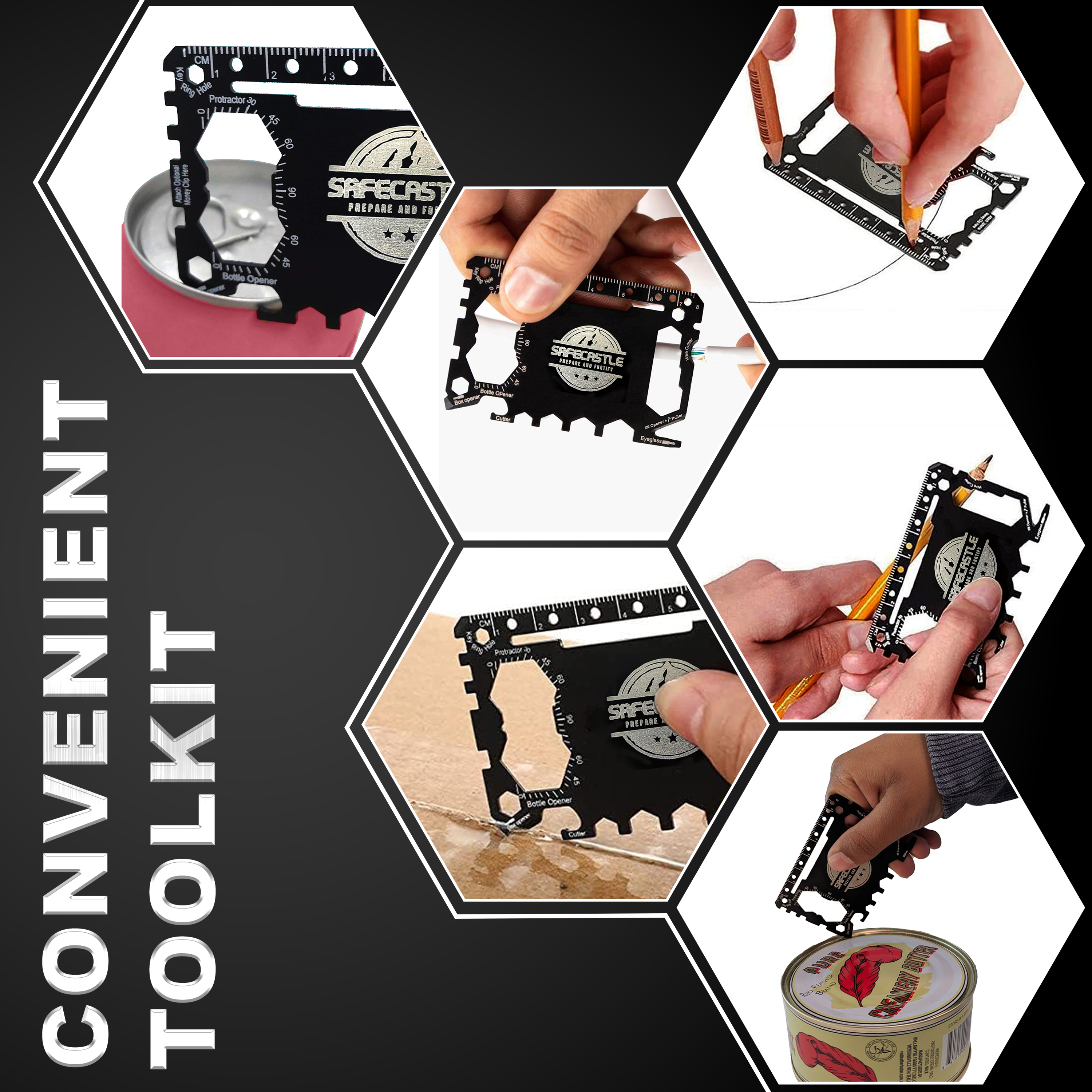The world you knew has crumbled. The undead roam the streets, and survival is your top priority. While a trusty crowbar might come in handy, neglecting your nutritional needs is a surefire way to become another member of the horde.
This blog post isn't about fear-mongering, but about taking control and feeling empowered. We'll explore the best canned food options for a long-term food supply, considering factors like nutrition, shelf life, and even taste (because surviving shouldn't mean sacrificing flavor!).
Why Canned Food?
While the zombie apocalypse might be fictional, real-world threats like natural disasters, power outages, and economic instability can disrupt food supply chains.
Canned goods boast an impressive shelf life, typically lasting 5-10 years past the "best by" date according to the National Center for Home Food Preservation. This is crucial when fresh food supplies dwindle.
No time for elaborate meals when zombies are on your tail. Canned food requires minimal prep, often ready to eat straight from the can or with a quick heat-up.
Canned food is compact and lightweight, making it ideal for bug-out bags and long journeys.
From protein-rich meats to vitamin-packed fruits and vegetables, canned goods offer a surprising variety to keep your diet balanced.
How to build a well-rounded canned food stockpile
Suggested Emergency Food Supplies · Ready-to-eat canned meats, fruits, vegetables and a can opener
Protein
Canned Tuna (in Water): A classic for a reason! Tuna is packed with protein (around 25 grams per serving) and Omega-3 fatty acids, essential for brain function (especially important for all that strategic zombie-evading!).
Canned Salmon: Another fantastic source of protein and Omega-3s, canned salmon also boasts a good amount of vitamin D, crucial for bone health during a potentially sedentary apocalypse.
Canned Chicken Breast: Lean and protean, canned chicken breast provides protein for building and repairing tissues.
Canned Beans (Kidney, Black, Pinto): The "meat" of the vegetarian world, canned beans are a powerhouse of protein, fiber, and essential minerals like iron and zinc. They're also incredibly affordable and filling.
Vitamin
Canned Vegetables (Corn, Peas, Green Beans): While not the most exciting, canned vegetables offer crucial vitamins and minerals that might be lacking in a long-term canned food diet. Aim for low-sodium options for better health.
Canned Tomatoes (Diced, Crushed, Whole): A resourceful and shelf-stable pantry staple, canned tomatoes add flavor and essential vitamins A and C to your meals.
Canned Fruits (Pineapple, Mandarin Oranges): Not just for dessert! Canned fruits provide a much-needed dose of vitamin C, essential for immune function, and a welcome burst of sweetness.
Calories: Aim for a minimum of 1,800 calories per day for most adults, but this can vary depending on activity level.
Don't Forget the Carbs
Canned Corn: While not the most nutritious option, canned corn adds valuable carbohydrates for energy, especially if fresh produce becomes scarce.
Canned Potatoes: A great source of complex carbohydrates and fiber, canned potatoes can be mashed, roasted, or added to soups and stews for a hearty meal.

Pro Tips for the Discerning Doomsday Foodie
1 Food Rotation:
Don't let your canned food stockpile turn into a museum exhibit! Rotate your stock regularly, using the oldest cans first and pushing the newer ones back. This ensures you always have fresh-tasting food on hand and avoids unpleasant surprises when you finally crack open a can of mystery meat.
2 Spice Up Your Life (After the Apocalypse):
While canned food might not win any Michelin stars, you can add some excitement with spices and herbs. Consider stocking up on dried spices like garlic powder, chili flakes, and oregano for a flavor boost.
3. Beyond the Can:
Remember, canned food should be a foundation, not the entire structure, of your post-apocalyptic diet. Consider supplementing your canned goods with non-perishables like dried pasta, rice, and nuts for added variety and nutrition.
Advanced Canned Food Strategies
If you have the time and resources, consider learning to can your own food. This allows you to preserve seasonal produce at its peak and personalize your stockpile with favorite foods. The National Center for Home Food Preservation offers a wealth of information and resources for safe home canning practices.
Pressure Cooking: A pressure cooker can be a lifesaver in the apocalypse. It drastically reduces cooking times, allowing you to prepare delicious and nutritious meals from canned goods even with limited fuel sources.

The All American pressure cooker offers the safest and best method for canning at home.
Water Purification: Clean water is essential for survival. Consider including a water purification method, like water powder or a portable filter, in your emergency preparedness kit. This allows you to safely consume water from potentially dubious sources and make the most of canned soups and stews.

Aqua Literz is emergency drinking water is filtered by reverse osmosis and packaged in an aseptic box with a flip open top for easy pouring.
Storage, Preparation, and Safety: Essential Considerations
Check for Dents and Rust: Dented cans can harbor bacteria, so inspect your cans closely before consuming. Discard any with dents, bulges, or rust.
Pay Attention to "Best By" Dates: The "best by" date indicates peak quality, not safety. However, avoiding cans that are significantly past their expiration date is a wise precaution.
In Case of Doubt, Throw it Out! When in doubt about the safety of a canned good, err on the side of caution and discard it. Foodborne illness is no joke, especially during a zombie apocalypse when medical care might be scarce.
Low-Sodium Options: Whenever possible, choose low-sodium canned food options. A high-sodium diet can lead to health problems, especially during a time when access to fresh produce and healthcare might be limited.

Our #10 Can of precooked freeze dried beef has a shelf life of 30 years, making this delicious meal the perfect addition to your emergency food supply
Even During the Apocalypse
By following this guide and incorporating some creativity, you can create a well-rounded canned food stockpile that will keep you nourished and, dare we say, content during the zombie apocalypse (or any other emergency situation). Remember, a little planning goes a long way, so get prepping and ensure you're ready to face the unknown with a full stomach!
Bonus Tip: Consider investing in a can opener that doesn't require electricity, like a manual can opener or a P-38 can opener (a handy tool often included in military rations kits).
What is the best weapon to survive a zombie apocalypse?

Movies and video games have been depicting zombie apocalypses for decades, showcasing a vast array of survival tools employed by resourceful protagonists. By analyzing these fictional scenarios, we can glean valuable insights into the practical equipment needed to stay alive in a world overrun by the undead.
Movies like "Train to Busan" (2016) and "Army of the Dead" (2021) showcase the effectiveness of bladed weapons for close-quarter combat. Axes, machetes, and katanas offer stopping power with minimal noise, but require close proximity and can become blunt with overuse.
From classic zombie flicks like "28 Days Later" (2002) to recent video games like "The Last of Us Part II" (2020), firearms remain a popular choice for dispatching zombies. However, ammo scarcity and noise generation are significant concerns.
Games like "Dying Light 2 Stay Human" (2022) highlight the importance of resourcefulness. Molotov cocktails and spiked boards can be effective against large groups, but require caution to avoid harming yourself.
Tools for Survival
First-Aid Kit: A well-stocked first-aid kit is crucial for treating injuries sustained during encounters or while navigating a ravaged environment. Games like "State of Decay 2" (2018) emphasize the importance of bandages, antibiotics, and pain relievers.
Real-World Recommendation: Invest in a comprehensive first-aid kit designed for wilderness survival. Learn basic wound care techniques like cleaning, disinfecting, and bandaging.
Navigation Tools: Reliable methods of finding your way are essential. Movies like "The Girl with All the Gifts" (2016) showcase the importance of maps and compasses. In the digital age, consider a portable GPS device with offline maps.
Real-World Recommendation: A combination of a physical map of your region, a compass, and a portable GPS device with downloaded offline maps provides redundancy in case of device failure.
Multi-Tool: A versatile multi-tool like a Leatherman or a Swiss Army knife offers a range of functionalities for repairs, crafting, and basic survival tasks. Look for features like pliers, screwdrivers, a knife blade, and a can opener.
Real-World Recommendation: Choose a multi-tool with features that best suit your anticipated needs. Consider size, weight, and durability when making your selection.
Security
Building Materials: Fortifying a safe haven is vital. Shows like "The Walking Dead" (2010-present) demonstrate the use of wood, metal sheets, and barbed wire to create barriers.
Real-World Alternatives: Sturdy plywood sheets, pre-fabricated metal fencing, and sandbags offer effective fortification materials.
Locks & Alarms: Deter opportunistic scavengers and wandering undead. While silent alarms are depicted in games like "Left 4 Dead 2" (2009), consider the limitations of battery life in a post-apocalyptic scenario.
Real-World Alternatives: Invest in high-quality padlocks for securing doors and windows. Motion-activated alarms with manual triggers offer flexibility and don't rely solely on battery power.
Communication Devices: Maintaining contact with survivors could be crucial.
Real-World Alternatives: Shortwave radios offer long-distance communication capabilities, especially for emergency broadcasts. Consider learning basic Morse code for non-verbal communication.
Sample Canned Food Apocalypse Meal Plan (One Week)
Day 1:
Breakfast: Oatmeal with canned fruit and nuts
Lunch: Chickpea salad sandwich on whole-wheat crackers
Dinner: Canned chili with a side of cornbread (made with a boxed mix and water)
Day 2:
Breakfast: Scrambled eggs with canned diced tomatoes and onions
Lunch: Tuna salad sandwich on whole-wheat bread
Dinner: Canned lentil soup with a side of canned green beans
Day 3:
Breakfast: Pancakes made with canned pumpkin puree
Lunch: Canned chicken breast with canned mixed vegetables
Dinner: Canned salmon with a side of mashed canned potatoes
Day 4: (Repeat a previous day or create your own!)
Day 5:
Breakfast: Canned fruit cocktail with yogurt (if available)
Lunch: Bean burrito using canned beans, canned corn, and salsa in a tortilla (or flatbread made with flour and water)
Dinner: Canned vegetable soup with a side of crackers and cheese (if available)
Day 6:
Breakfast: Cereal with canned milk (if available)
Lunch: Leftover bean burrito
Dinner: Canned pasta with canned tomatoes and spices (add canned vegetables if available)
Day 7:
Breakfast: Protein bar (if available) and a handful of nuts
Lunch: Canned tuna with crackers and a side of canned peas
Dinner: Leftover canned pasta
Remember: This is just a sample plan. Feel free to get creative and substitute ingredients based on your preferences and what's available in your pantry.
Reference: https://nchfp.uga.edu/how/can


